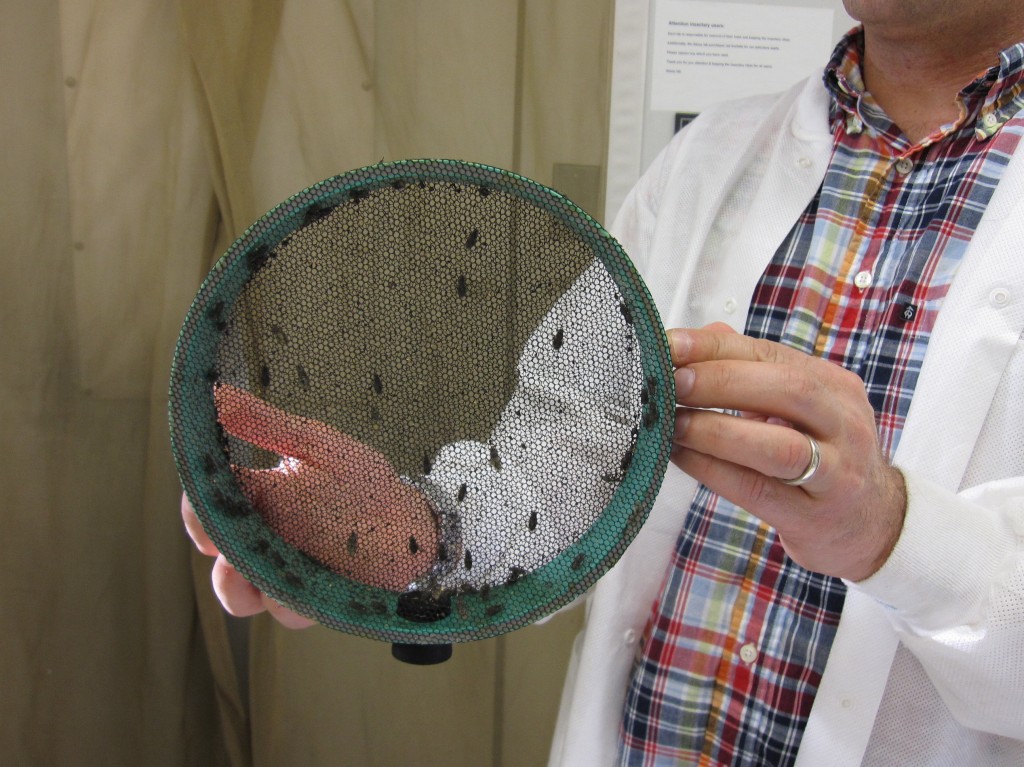
Yesterday I shared a room with 3,000 buzzing tsetse flies – the bugs that carry the sleeping sickness parasite.
Tsetse flies live in Africa, but these guys are Yalies. They buzz and breed in racks of mesh cages on the 6th floor of Yale’s School of Public Health. (They also recite some Goethe – it’s the Ivy League, after all). By studying their inner workings, scientists like Serap Askoy hope to figure out how to stop them from spreading the parasite.
Three things you may not know about tsetse flies:
1. Female flies give birth to live babies (ok, you might call them maggots).
2. They produce milk for their maggots. Tsetse milk is similar to mammal milk, but the larvae only get to nurse inside the womb. After birth, they’re on their own.
3. And from the Annals of You-Must-Be-Joking, tsetse flies carry a bacterium called Wigglesworthia, named for the British entomologist who first described it: Sir Vincent Brian Wigglesworth. I’m not kidding. Wigglesworthia.
Tsetse flies don’t just have Wigglesworthia, they need them. The bacteria produce nutrients that enable the tsetse flies to reproduce. Female flies lacking these bacteria are sterile.
Wigglesworthia (it just makes me happy to write it) comes in two flavors: The first kind lives inside the fly’s cells in a special organ in the gut. The second kind floats freely in the space between cells in the female’s milk glands. When the baby maggot feeds, it ingests not only milk, but also a hefty helping of Wigglesworthia.
But, if you give a tsetse fly the antibiotic ampicillin, as these researchers did, Wigglesworthia dies. The antibiotic can’t penetrate the fly’s cells, however, so only the bacteria in the milk glands die. Thus mom fly, who still has Wigglesworthia, can have a baby, but her daughters, who don’t have the bacterium, can’t. They’re sterile.
How will this knowledge lead to the control of sleeping sickness? Yes, that would have been a good question for me to ask while I was standing in the tsetse lab. But I didn’t. So I can only guess. Perhaps we could promote tsetse fly sterility by hanging bags of ampicillin-laced blood in the African bush? (There’s a reason I’m not a public health policymaker).
**
Image credit: Cassandra Willyard
“Tsetse” is also an unusually common crossword answer.
Cool story, Cassie 🙂
This is fascinating and funny, too. Reminds me of the time I visited a blowfly-breeding lab at the UC Irvine. They breed the blowflies for their maggots, which are used for treating diabetic ulcers and the like – long story. Dreadfully smelly place. –Josie
Mike: Thanks!
Josie: Maggots to clean out ulcers?!?
Horrifying! But now that you mention it, I do remember hearing about maggots being used for would cleaning. Makes sense, I guess.
Um, yes. Maggots are sometimes used to clean out diabetic ulcers (especially when modern methods haven’t worked) because they eat only dead tissue and not living cells. It’s apparently painless and quite effective. I saw the little wrigglers in action at a Cleveland hospital. The patient was quite nonchalant about it all.
Tsetse is such a cool name for an insect, even for a bug. I wonder if touching it would mean sleeping sickness for me.
is that you Brian???
I’m not sure how this information will be helpful for me personally but I do love to learn new and interesting things. I think they are just trying to figure out how it works so maybe that will help lead them to a cure for the sleeping sickness. Wigglesworthia…your right it is fun to type and even more fun to say.
Fascinating the symbiotic nature some bugs have with bacteria.
If they could pull this off the removal of the bacterium. it sounds like the end of sleeping sickness. That would be a great thing.
Interesting but kind of gross. When I hear about things like sleeping sickness, malaria and AIDS in Africa, it makes me extremely grateful to live in the US.
I know comets and stuff like that are named after the person who discovered them but I’m not sure I would want a bacteria named after me.
What an Interesting article!! Am I the only one who was constantly scratching by the half-way point?? Its amazing where we are willing to look for medical answers. I mean really, who decided to put millions into research on a whim? This will make for great water cooler conversation, THANKS AGAIN!!
I hate flies! I really hate them. They are a disturbance especially when I cook. That’s why I bought a lot of fly traps.